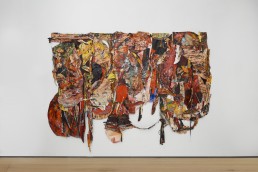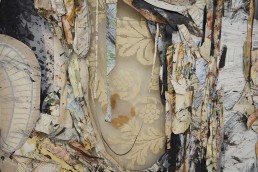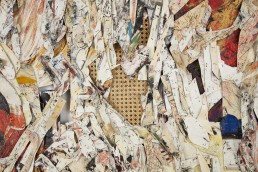Articles and Features
After the Storm, Rebuild: Angel Otero’s Milagros
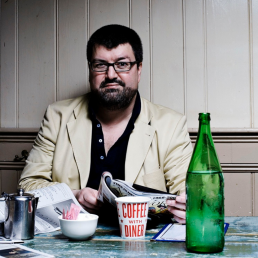
| Christian Viveros-Fauné | Kulchur Vulture |
About: Viveros-Fauné is Artland’s inaugural Chief Critic and the contributor of this regular column. Based in New York City, he writes primarily about exhibitions and the cultural landscape there. His articles also often feature Artland’s revolutionary and market leading Artland 3D, virtual exhibition tours that enable the viewer to pay compelling virtual visits to actual exhibition spaces in support of the texts.

| Christian Viveros-Fauné |
| Kulchur Vulture |
According to C.S. Lewis, miracles are retellings, in tiny type, of stories written across the world in letters too large for most people to see. That idea hovers over an eye-bending array of large-scale, tapestry-like paintings by New York artist Angel Otero at Chelsea’s Lehmann Maupin gallery.
The word milagros, which serves as the show’s title, means “miracles” in Spanish. It also accounts for the marvelous way the artist cobbles together bits of cut-up paint, fabric and found materials that cohere into compositions suggesting tempest-bearing seas, whirlpool-like voids and island-flattening storms.
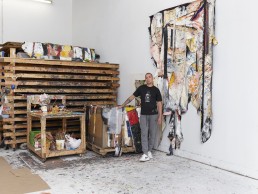
Courtesy the artist and Lehmann Maupin, New York, Hong Kong, and Seoul. Photo: Elisabeth Bernstein.
Viveros-Fauné is Artland’s inaugural Chief Critic and the contributor of this regular column. Based in New York City, he writes primarily about exhibitions and the cultural landscape there. His articles also often feature Artland’s revolutionary and market leading Artland 3D, virtual exhibition tours that enable the viewer to pay compelling virtual visits to actual exhibition spaces in support of the texts.
According to C.S. Lewis, miracles are retellings, in tiny type, of stories written across the world in letters too large for most people to see. That idea hovers over an eye-bending array of large-scale, tapestry-like paintings by New York artist Angel Otero at Chelsea’s Lehmann Maupin gallery.
The word milagros, which serves as the show’s title, means “miracles” in Spanish. It also accounts for the marvelous way the artist cobbles together bits of cut-up paint, fabric and found materials that cohere into compositions suggesting tempest-bearing seas, whirlpool-like voids and island-flattening storms.

Courtesy the artist and Lehmann Maupin, New York, Hong Kong, and Seoul. Photo: Elisabeth Bernstein.
A native of San Juan, Puerto Rico, the Brooklyn-based Otero has spent the last decade methodically pioneering a unique painting process. Rather than paint directly on canvas, the artist brushes entire scenes onto large sheets of glass; he then scrapes the partially dried oil paint from the surface, and collages these “paint skins” into multi-layered compositions. Since 2007, Otero has made his heterogeneous pictures increasingly more complex. His most recent abstractions foment an even greater intricacy; paradoxically, the results conjure a painterly simplicity that is oceanic in its sweep.
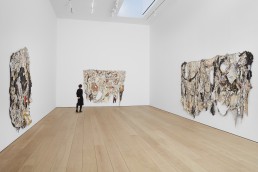
Angel Otero: Milagros, New York, W 24th Street. March 7 – April 20, 2019. Photo: Matthew Herrmann.
Courtesy the artist and Lehmann Maupin, New York, Hong Kong, and Seoul.
Building on the epic-sized works featured in his 2017 exhibition “Angel Otero: Elegies” at The Bronx Museum—disclaimer: I had the good fortune to curate that show—Otero’s newest pictures deploy discrete fragments of dried pigment, cloth and other materials like Paul Cézanne once did jangly planes of color. Stitched and stapled together from actual cut-and-paste brushstrokes, Otero’s paintings appear to float off the gallery walls. The fact that they hang from single stretcher bars creates shadows that reinforce their physical presence more than most conventional two-dimensional pictures.
Angel Otero, Red Milagro, 2018. Oil skins on fabric. 107 x 142 x 5 inches; 271.8 x 360.7 x 12.7 cm. Courtesy the artist and Lehmann Maupin, New York, Hong Kong, and Seoul.
Photo: Matthew Herrmann.
Take Red Milagro (2018), for instance. An immense blanket of red, orange and black pigment the artist mostly scavenged from reworked paintings, the work’s quilt-like fabric also features several instances of negative space. A meticulous construction, the painting’s composition’s dazzles no less for its saturated palette and patchwork design than for the gaping holes the artist left for viewers to fill in. Are these voids, windows or the eyes of churning storms? Whatever the case, they’re large enough for false promises and lost illusions to fall through.
A second gallery of mostly black and white paintings feature four sown together paintings sporting more of Otero’s mysterious ruptures. One such painting, Casting Light (2019), fills in its breaches in with three chandelier crystals. A third painting titled Sarcophagus (Eat the Meat and Spit Out the Bones) (2019) displays an all-over pattern of cutout pigment and cloth resembling a choppy sea. The fact that Otero covers some of its apertures with pieces of rattan indicates the artist may have used readymade material. Was it found discarded on his long-suffering island?
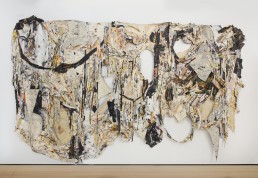
Angel Otero, Sarcophagus (Eat the Meat and Spit Out the Bones), 2019.
Oil skins on fabric. 108 x 172 x 4 inches; 274.3 x 436.9 x 10.2 cm.
Courtesy the artist and Lehmann Maupin, New York, Hong Kong, and Seoul. Photo: Matthew Herrmann.
Complex curtains of languorous shape and color offset by Rorschach-like passages, Otero’s latest works assume the role of screens on which the viewer can project a million images, narratives, and correspondences. One of them is the devastation still affecting Puerto Rico two years after Hurricane Maria made landfall. Otero’s paintings affirm an unequivocal message—rebuild.
There be miracles there.
A second gallery of mostly black and white paintings feature four sown together paintings sporting more of Otero’s mysterious ruptures. One such painting, Casting Light (2019), fills in its breaches in with three chandelier crystals. A third painting titled Sarcophagus (Eat the Meat and Spit Out the Bones) (2019) displays an all-over pattern of cutout pigment and cloth resembling a choppy sea. The fact that Otero covers some of its apertures with pieces of rattan indicates the artist may have used readymade material. Was it found discarded on his long-suffering island?

Angel Otero, Sarcophagus (Eat the Meat and Spit Out the Bones), 2019.
Oil skins on fabric. 108 x 172 x 4 inches; 274.3 x 436.9 x 10.2 cm.
Courtesy the artist and Lehmann Maupin, New York, Hong Kong, and Seoul. Photo: Matthew Herrmann.
Complex curtains of languorous shape and color offset by Rorschach-like passages, Otero’s latest works assume the role of screens on which the viewer can project a million images, narratives, and correspondences. One of them is the devastation still affecting Puerto Rico two years after Hurricane Maria made landfall. Otero’s paintings affirm an unequivocal message—rebuild.
There be miracles there.
